Hi-Protein Delicious Vegan Pumpkin Curry with Tofu.

Easy.
Delicious.
Hi-Protein.
And heart healthy!
I developed this recipe to use some of the pumpkin I’d carved up and to create a delicious, satisfying bowl of food for my husband. We are both athletes, so protein is something we are mindful of (not overly so). But we are also quite keen on getting in our daily dose of fiber!
So strap in, because pumpkin season is HERE and this delicious pumpkin curry recipe is one the whole family can enjoy!
Disclaimer: Some of the links in this post may be affiliate links for products I use and love. If you make a purchase after clicking one of those links, I may earn a small affiliate commission, perhaps enough to buy some extra gochujang or gochugaru 🙂
What is Pumpkin Curry?

Perhaps like you, I wondered whether “pumpkin curry” is a “real dish.” “Real,” I guess, as in, it’s not one of these made up pumpkin recipes that food bloggers created in order to take advantage of the pumpkin frenzy that descends upon the US and other parts of the Western world in the fall. A little digging around and I learned that yes! Pumpkin curry is enjoyed in Thailand and India, where curry is obviously a staple of their respective cuisines. This recipe is inspired by a Thai pumpkin curry recipe or Kaeng Fuk Thong.
What even is “curry”? I wondered the same thing. Simply put, curry is a sauce or gravy that is seasoned with multiple spices, usually associated with Indian or Southeast Asian cuisine. What is the difference between Indian pumpkin curry and Thai pumpkin curry? Well, as you might guess, Indian pumpkin curry incorporates Indian spices (like ground turmeric, cumin seeds, and ground cardamom), while Thai pumpkin curry starts with a Thai curry paste. I’ve also discovered that many Thai curry recipes utilize creamy coconut milk as a way of thickening their sauce, which is great news for vegans or those who are lactose intolerant.
The one thing they both have in common is that the best results come from layers of flavor, which is the key to this pumpkin curry recipe. This is a vegan pumpkin curry recipe with a Thai red curry paste as its base flavor. So, get ready for a little heat!
Why You’ll LOVE This Pumpkin Curry Recipe.

This pumpkin curry recipe is most certainly going to become one of your favorite recipes, because it’s:
- EASY. I say this is about almost all my recipes, but that’s because it’s TRUE. I don’t do a lot of difficult recipes, and this vegan pumpkin curry recipe is no exception. It’s about as easy as 1-2-3 and that’s on purpose: I want to be able to make this recipe as quickly and effortlessly as possible!
- HI-PROTEIN. This pumpkin curry recipe is packed with plant-based protein. It is the perfect post-workout meal or a go-to recipe for those looking to up their healthy protein intake! No protein powders needed!
- CUSTOMIZABLE. There are so many substitution possibilities with this easy pumpkin curry recipe! You can use tempeh instead of tofu. Butternut squash instead of pumpkin (though, then it wouldn’t really be a pumpkin curry)! And the vegetables you add to this curry are really up to you. Go with what you have and what you love! This is the perfect dish to incorporate all your favorite veggies!
- LOW OIL. This recipe has very little oil in it and you can absolutely make this vegan curry recipe with no oil. I’ve been experimenting more and more with no-oil plant-based recipes and have found that soups and stews and sauces are GREAT for no-oil cooking. This pumpkin curry recipe is no exception!
Key Ingredients and Notes on Substitutions for Pumpkin Curry Recipe.
With colder months in our future, I love making meals that take advantage of seasonal ingredients while keeping me satisfied. I dunno about you, but this is NOT the time of year I’m looking for “light meals”! I want something that’ll stick to my ribs! This pumpkin curry recipe is packed with nutrient dense, hi-fiber, and hi-protein ingredients, with a wide range of antioxidants designed to fuel a fit and active lifestyle. The best part? None of these ingredients are difficult to get!
So, let’s get into it!
Pumpkin.

Surprise, surprise, this pumpkin curry recipe calls for, you guessed it:
PUMPKIN!
Specifically, this savory pumpkin recipe requires both fresh pumpkin cubes (which are boiled) and pumpkin puree. Both of these can be purchased at the grocery store (i.e., you don’t need to make your own homemade pumpkin puree, though do not try to make this recipe with pumpkin pie filling…!). That said, if you want to impress folks, don’t be intimidated by purchasing a whole pumpkin (you can use a small one) and carving it up for this curry dish. You can always freeze what you don’t use and bust it out for next time!

In terms of substitutions, as I mentioned above, this pumpkin curry recipe is very versatile and can be modified for a variety of ingredients: kabocha, sweet potatoes, butternut squash. Obviously, switching out the pumpkin will technically render this NOT a “pumpkin curry,” but it’ll still be absolutely delicious!
Red Curry Paste.

Thai curries usually begin with one of three curry pastes: yellow curry paste, red curry paste, and green curry paste. This pumpkin curry recipe calls for a red curry sauce and hence, we will be utilizing the red curry paste. What is the difference between the three pastes? Primarily, it is a matter of spice. Yellow is mild, red is medium, and green is spicy! What brand do I like to use? I prefer the Thai Kitchen brand for this curry, mainly because it’s easy to find and relatively inexpensive, and tastes great.
In terms of substitutions, you can, of course, substitute with whatever brand of red curry paste you like. You can also change the color of the curry paste. If you have trouble with overly spicy food, go with the yellow Thai curry paste. If you LOVE spicy food, consider amping it up with a green paste!
Super Firm Tofu.
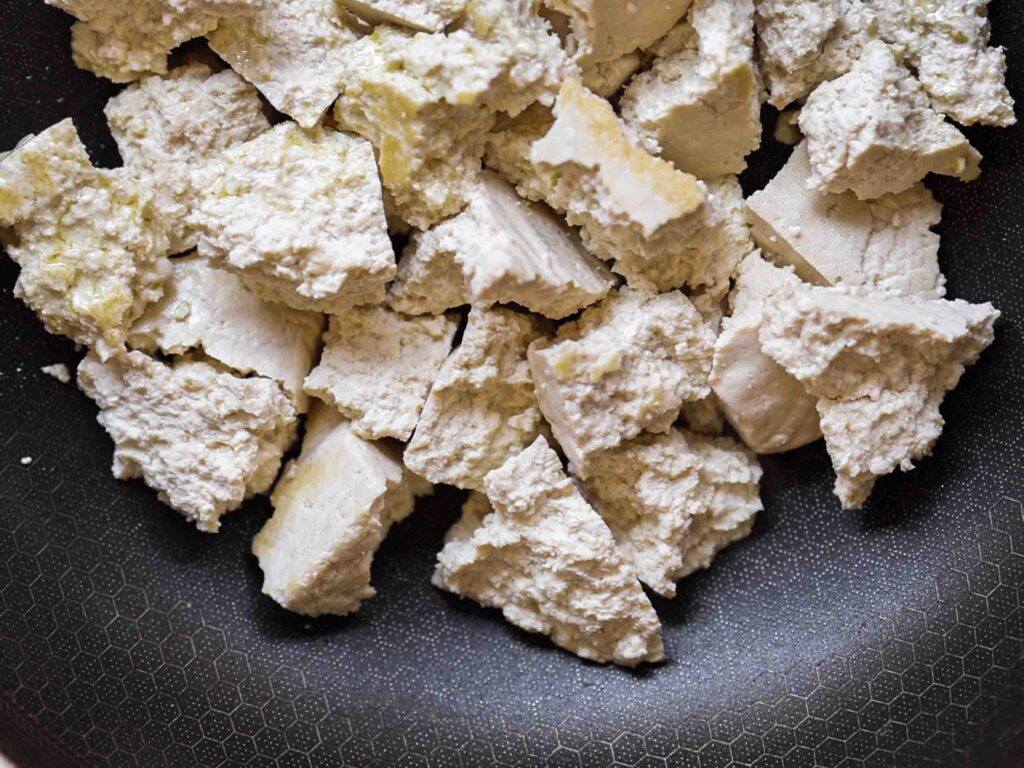
This is a hi-protein pumpkin curry dish. We actually have multiple sources of plant-protein in this dish and the first of these is super firm tofu. I like super firm tofu because, in my mind, it does the best job of mimicking chicken breasts, which is what many authentic Thai curries are made with. Super firm tofu has so much liquid already pressed out of it, you don’t need to press it.
However, if you can’t get your hands on super firm tofu, you can absolutely use extra-firm tofu. Simply press it for about 10 minutes before cooking to render out some of the excess liquid.
Cannellini Beans.
One of my favorite tricks for making a sauce thick and creamy is using beans. They are packed with plant-protein and fiber and do such an excellent job of thickening a sauce without gums or flour. Here, I use a whole can of cannellini beans to help thicken our Thai pumpkin curry into a rich, nutrient-dense gravy that’ll definitely stick to your ribs–but in a good way!
If you don’t have access to cannellini beans, you can always substitute with chickpeas, navy beans, butter beans, or pinto beans!
Gochujang and Soy Sauce.

Of course, gochujang is not going to be in a traditional Thai curry recipe. But, I like to add a dollop of Korean everywhere I go, I suppose! I add just one heaping spoonful of gochujang to this recipe to give it a little extra heat, a little extra umami, and a little bit of me. You can skip it or replace it with tomato paste or another spoonful of Thai curry paste!
I also like to add a splash of soy sauce to this recipe for extra savoriness (is that a word?). You can, of course, use fish sauce too (I have the perfect vegan recipe for that!) or a pinch of salt.
Maple Syrup.
I wanted to give this pumpkin curry recipe a little bit of sweetness to complement the apples and the coconut milk, so I add just a tablespoon of maple syrup. If you prefer your curries on the more savory end of things, you can always skip the maple syrup. If you like yours on the sweeter side, add a bit more or use brown sugar.
All The Vegetables (And Fruits!).



This is definitely one of those “clean out the fridge” recipes, where all the extra veggies sittin’ around in your refrigerator or on your kitchen counter can come into play. In addition to pumpkin, I used the following fruits and vegetables in this pumpkin curry recipe:
- Onion
- Garlic
- Red bell pepper
- Zucchini
- Apple
- Green Thai chilis

The sky’s the limit when it comes to replacements or additions (though, I wouldn’t add too much more, lest the flavors become muddled). You can use green bell peppers instead of red ones. You can also use potatoes instead of zucchini. You can use pear instead of apple. Throw in a carrot, corn, or even some peas for more protein. If you don’t like too much heat, add only one chili instead of two or use a jalapeno instead. Nix all the chilis altogether if you really can’t stand the heat!
Light Coconut Milk.

As is typical of many Thai curry recipes, this pumpkin curry recipe calls for coconut milk. Here, I used light coconut milk because I’m trying to keep this recipe low fat. But if you have room for it, use the full fat coconut milk!
I would not try to substitute the coconut milk for another plant-milk, as the coconut flavor is a part of what makes this dish a Thai-inspired curry.
Thai Basil.
To garnish this pumpkin curry dish, I used a little bit of torn Thai basil. If you’ve never had Thai basil before, you’re in for a treat! It’s as sweet as Italian basil, but gives a little more licorice flavor (like anise). The leaves are slender, instead of fat, and you can easily find them at most grocery stores or farmers markets!
Toasted Pumpkin Seeds.
And for that final flourish of pumpkin-protein goodness, add a few toasted pumpkin seeds before chowing down!
Step-by-Step Instructions for Making Pumpkin Curry.
As I’ve mentioned, this pumpkin curry is a very easy recipe and comes together quite quickly. So, let’s get to it!
Step 1.
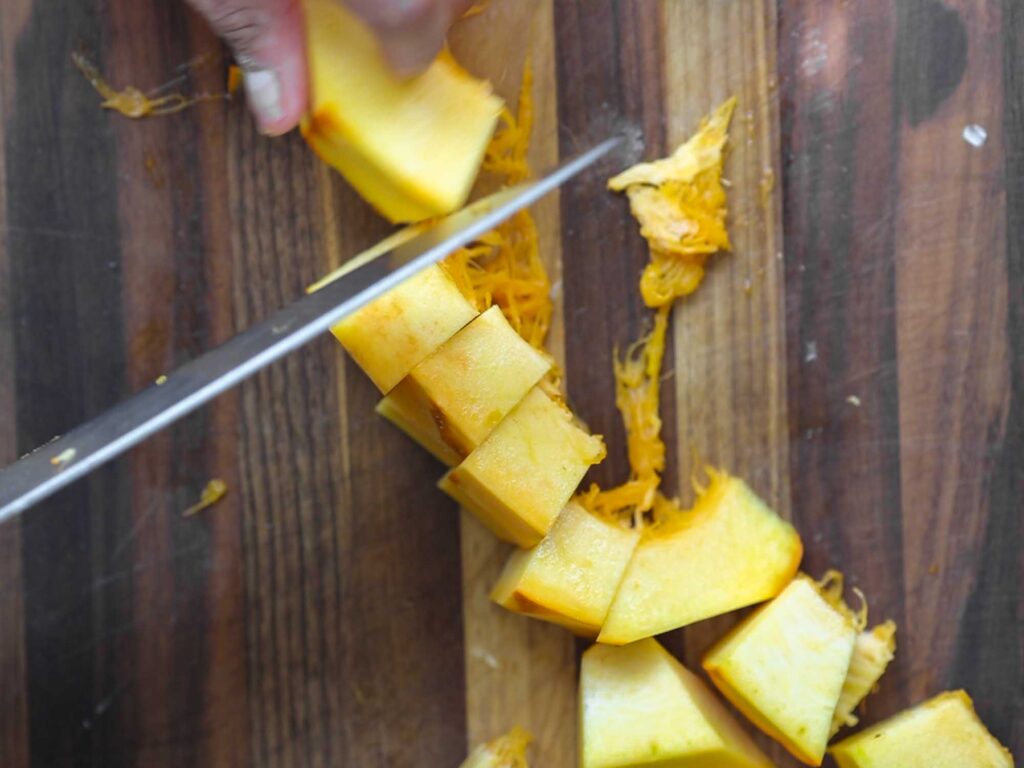
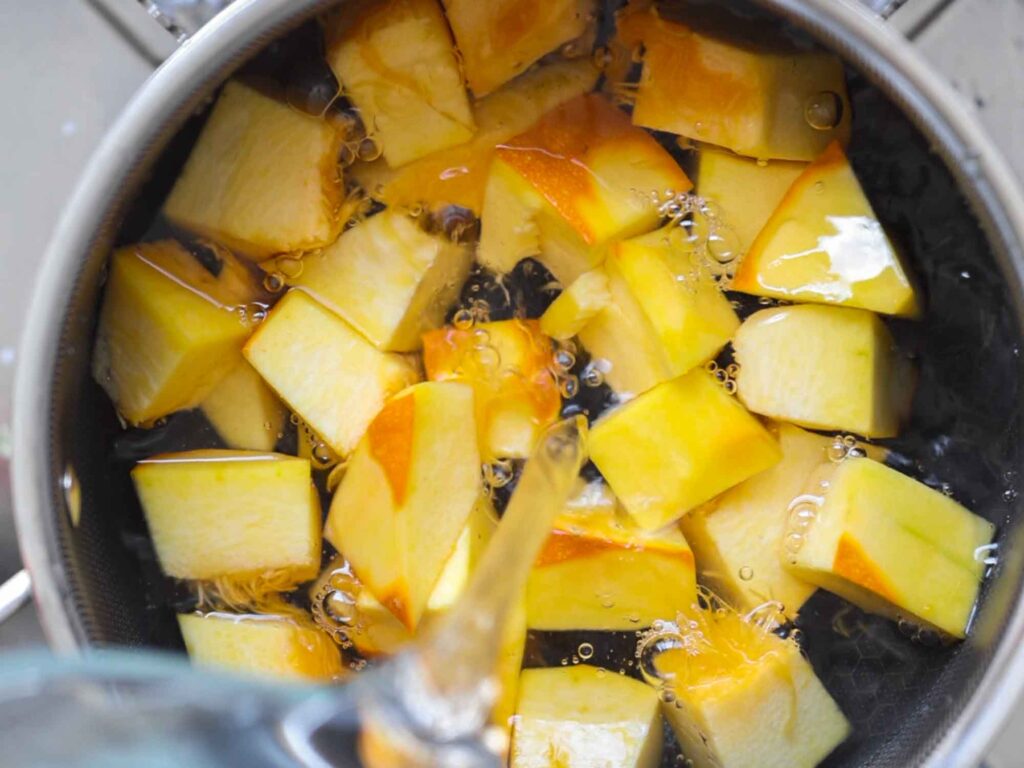
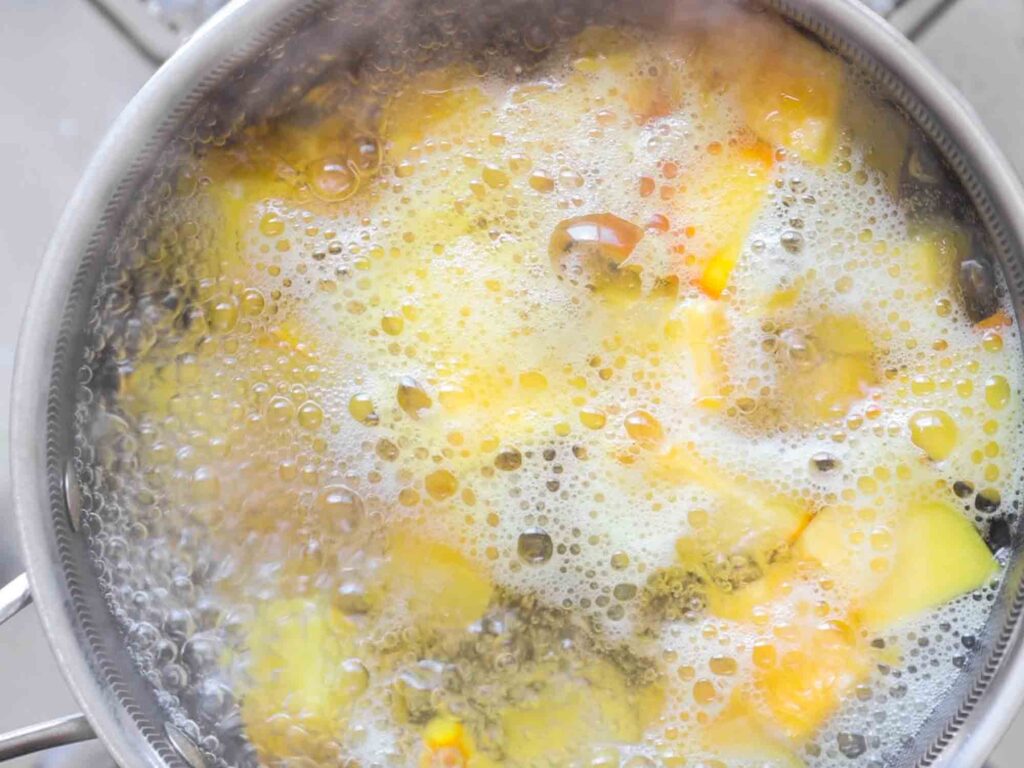
First, cut your pumpkin into 1-inch cubes and boil your pumpkin cubes in a little water until they are fork tender (around 15 minutes).
Step 2.
While your pumpkin cubes are boiling, add a tiny bit of extra virgin olive oil to your wok or pan over high heat. When it starts to shimmer (in about 1-2 minutes), break your super firm tofu into 1-inch chunks using your hands. Why do this in lieu of slicing the tofu up into nice, neat cubes? The natural crags of your chunky tofu will help to “catch” the curry you’re making! Sautè your tofu chunks for about 7 minutes, until they begin to brown. Set aside.

OIL-FREE MODIFICATION: If you’d like to keep this recipe oil-free, you can skip this step and add the tofu later!
Step 3.
To the same wok in which you cooked your tofu, over medium-high heat, add 1/4 cup of red curry paste, together with 3 to 4 tablespoons of vegetable broth. Stir the contents until the liquid begins to bubble (about 1 minute). Add to the wok the onion and garlic and sautè until the onions start to grow soft (about 3 minutes). Next, add the rest of your fruits and veggies (zucchini, red bell pepper, apple, and chilis), along with gochujang, pumpkin puree, maple syrup, and cannellini beans. Stir until all the veggies are evenly coated.




Step 4.
Deglaze the pan with a little soy sauce. Then add vegetable broth, along with the creamy white part of your coconut milk (not the clear liquid–though, if you get a little bit in there by accident, that’s not a problem). Bring the contents of your wok to a boil and reduce heat and cook until vegetables are fork tender (around 7 to 8 minutes).



Step 5.
Season with a little bit of cracked black pepper. Give your sauce a taste at this point and add more salt, as necessary. Remove about 2 cups of the contents of your wok and place it in a bowl. Set it aside. Using an immersion blender or a regular blender, blend the remaining contents of your sauce until creamy. If you use an immersion blender, the sauce will be more of a rustic affair. If you use a traditional blender, it’ll be nice and smooth.


Add back in the tofu (or if making this oil-free, simply add the uncooked tofu) along with boiled pumpkin cubes and the reserved, unblended portion of the sauce, and incorporate, adding a bit more vegetable broth if the sauce is too thick for your taste.

To serve, add curry sauce over a bowl of long grain white rice or brown rice. Drizzle with a little extra coconut milk and garnish with Thai basil and toasted pumpkin seeds. Give it a good crack of black pepper and DONE!!
Delicious pumpkin curry at your service!

Frequently Asked Questions.
Can pumpkin curry be made gluten-free?
Yes! Just use gluten-free gochujang and soy sauce and this pumpkin curry recipe is entirely gluten-free!
Can I use store-bought pumpkin puree for this pumpkin curry?
Absolutely! This pumpkin curry recipe tastes great with either homemade or store-bought pumpkin puree! Just make sure it’s actually pumpkin puree and not pumpkin pie filling (they often look similar)!
How long will this pumpkin curry last?
This pumpkin curry can be stored in the refrigerator in an airtight container for up to five days. Any longer and you’ll want to freeze it. To reheat, simply add a little vegetable broth or water and place it in the microwave or on the stovetop over medium heat, until it’s nice and warm!
Is pumpkin popular in Thai cooking?
As a matter of fact, pumpkin is one of the most frequently used squashes in Thai cuisine! Pumpkin curry is sometimes referred to as Kaeng Fuk Thong and is made using Thai curry paste, pumpkin, and coconut milk.
Is pumpkin curry healthy for you?
Pumpkin curry can definitely be part of a heart-healthy diet. Pumpkin, along with some of the other vegetables that are found in pumpkin curry, provide an excellent source of fiber, which has been shown to reduce cholesterol.
Recipe Card.
Hi-Protein Vegan Pumpkin Curry.
Equipment
- 1 immersion blender (or regular blender)
Ingredients
- 2 cups chopped pumpkin cubes (1-inch)
- 1 tbsp extra virgin olive oil
- 16 oz super firm tofu
- 1/4 cup Thai red curry paste
- 6 cups vegetable broth
- 1/2 cup sliced onion
- 3 cloves minced garlic
- 1/2 cup chopped red bell pepper
- 1 cup chopped zucchini
- 1 cup chopped apple
- 2 green Thai chili, chopped
- 1 3/4 cup cannellini beans
- 2 tbsp gochujang
- 1/2 cup pumpkin puree
- 1 tbsp soy sauce
- 1 tbsp maple syrup
- 1/2 tsp sea salt
- 1 tsp black pepper
- 1 can light coconut milk (white part only)
- 8 to 10 leaves fresh Thai basil
- 1/4 toasted pumpkin seeds
Instructions
- Add your pumpkin cubes to a small pot of water. Bring to a boil and cook until fork tender (around 15 minutes in total). Drain and set aside.
- (Skip this step if using oil-free modification) While pumpkin is boiling, add extra virgin olive oil to a large pan or wok over high heat. When the oil begins to shimmer (about 1 minute), break your super firm tofu into 1-inch chunks into the pan. Sautè for about 7 to 8 minutes, until they begin to brown. Set aside.
- In the same wok, add Thai red curry paste, along with 1 to 2 tablespoons of vegetable broth. Cook over medium-high heat, stirring the paste until it begins to bubble. Add onions and garlic. Sautè until onions soften and garlic is fragrant (about 2 to 3 minutes). Add red bell pepper, zucchini, apple, green chili, and cannellini beans, along with gochujang, pumpkin puree, and maple syrup. Stir until all the veggies are evenly coated.
- Deglaze your pan with soy sauce, stirring so that the veggies are evenly coated. Then, add the rest of your vegetable broth, along with coconut milk (just the white part). Season with black pepper and extra salt (if you think it's necessary). Bring the contents to a boil and then reduce to your heat to low and cook until the vegetables are fork tender (around 7 to 8 minutes). Remove about 2 cups of sauce and place in a bowl. Set this aside.
- Blend the rest with either an immersion blender (for chunkier sauce) or a traditional blender (for a smooth sauce). Place the blended sauce back in the pan. Add back the tofu (or add it uncooked if using oil-free modification), along with boiled pumpkin, and unblended portion of curry sauce. Stir until everything is well-combined. If the sauce is too thick for your taste, add a bit more vegetable broth over low heat until it reaches your desired consistency.
- To serve, add curry sauce to a bowl of long grain white or brown rice (or just serve with some lovely, rustic bread!). Drizzle with any left over coconut milk and garnish with fresh Thai basil leaves, toasted pumpkin seeds, and a crack of black pepper.
Nutrition
Did you like this recipe? If so, please leave a rating and share it!





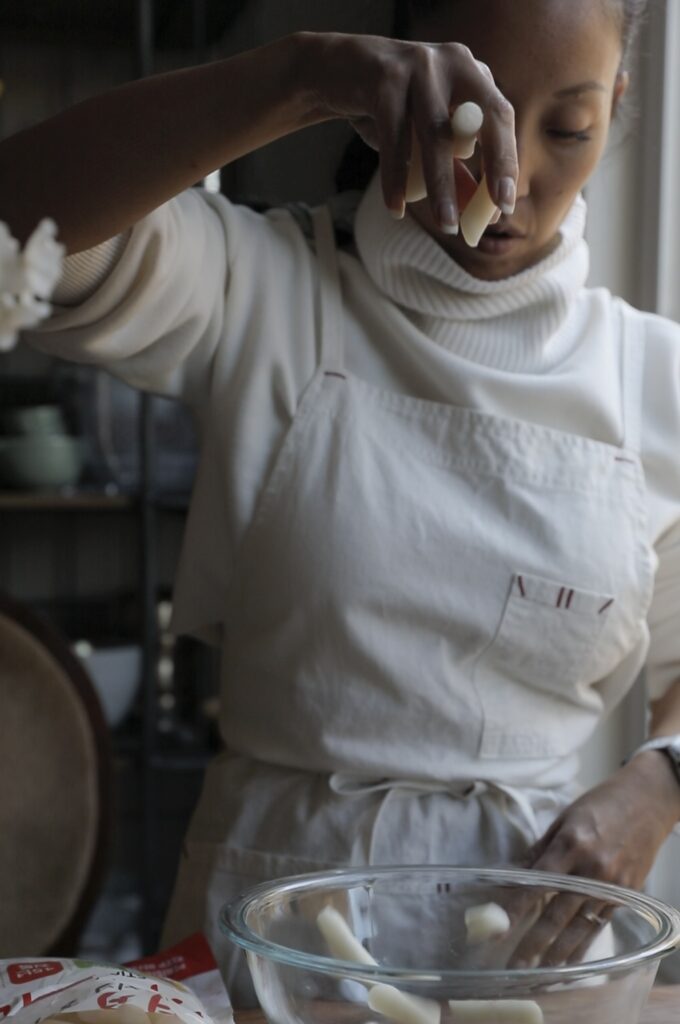


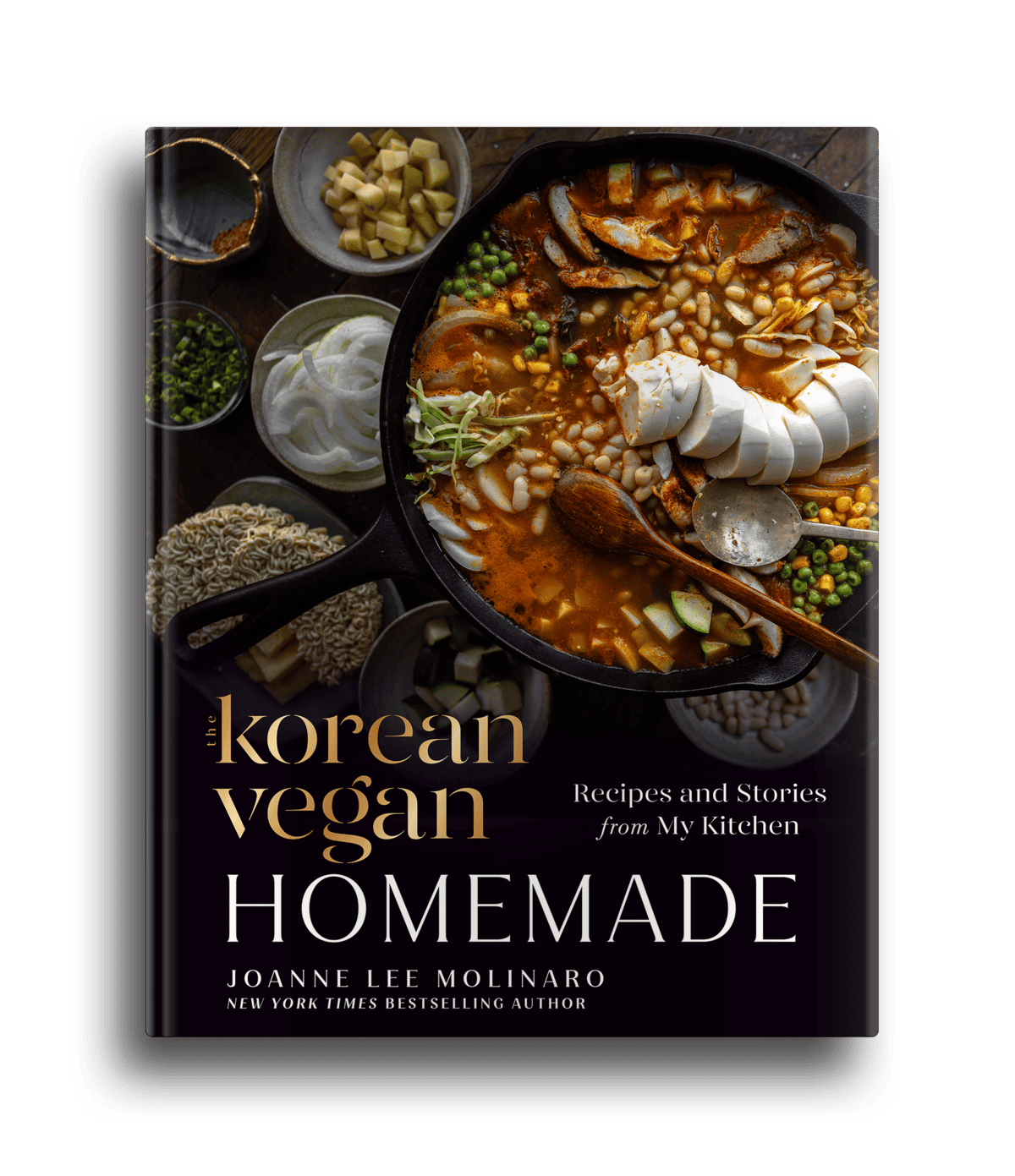
love love love the flavors and process on this. i also think it could use a little less broth if you want it thick like the pics. 4 cups is is probably enough, then an additional cup to thin if needed. it turned out soupy both times i did it, but dang it was still so good over rice!
Made recipe exactly following every instruction. Flavours are amazing but it’s far too watery. I have essentially a relatively thin soup rather than a curry. It’s nice as a soup but not as a curry.
Hi Linda, thanks for trying the recipe and for sharing your feedback!
I feel like the recipe is missing a flavor profile…which I think is umami. It does give a good heat. Because it felt like it was missing something I added cashews and pineapple at the end…but still was a bit off. As someone else commented it does take longer with chopping veggies etc and did use less broth. Maybe roasting the pumpkin would be better to develop more of the flavors. My fav recipe has got to be the spicy crispy garlic tofu, that is packed with punches of flavor for days.
First off- this is a delicious recipe! All of the flavors come together so harmoniously! However, as an at home cook- please be aware that the prep time for this is significantly longer if you are chopping and peeling pumpkin, and chopping the other fruits and veggies. I also only used about 4 cups of broth- and it was plenty to have a nice consistency after blending. I will definitely make this again!